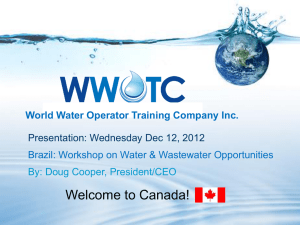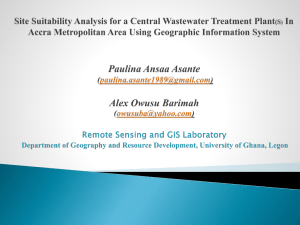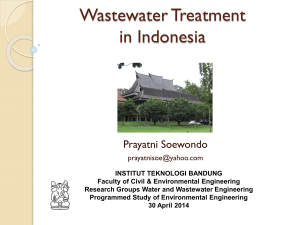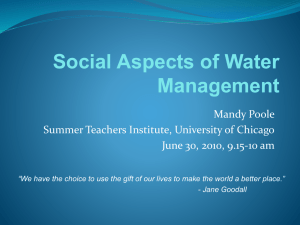Here - Township of Blandford
advertisement
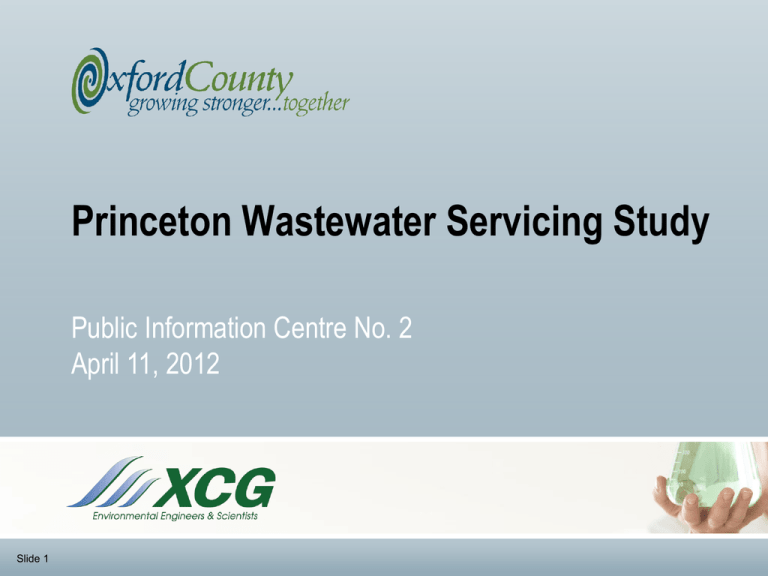
Princeton Wastewater Servicing Study Public Information Centre No. 2 April 11, 2012 Slide 1 Water System Update System will be commissioned in May and ready for connections All properties will receive notification at that time CSAP program has been reviewed by Council and the maximum cost to residents for water has been capped at $9,500. Princeton residents will pay will this amount and not the actual cost of $12,600 (after CSAP grant). Presentation Agenda Slide 2 Finalized Problem/Opportunity Statement Alternatives Evaluation of Alternatives and Evaluation Criteria Evaluation Results Public and Agency Consultation Study Schedule and Next Steps Purpose of PIC To present, review and discuss results of preliminary evaluation of alternatives To gain input from the Community on the information presented Slide 3 Study Background During the Princeton Water Servicing Study, the County received a petition signed by 130 Princeton residents, requesting that a wastewater servicing study be completed for Princeton Upon receiving the petition: Oxford County Public Works and Public Health and Emergency Services Departments reviewed all un-serviced and partially serviced villages A priority list was developed for wastewater servicing studies based on public health and environmental concerns Princeton was identified as having the highest priority for investigating wastewater servicing alternatives Slide 4 Study Objective Princeton Wastewater Servicing Study Objective Overall objective of the Princeton Wastewater Servicing Study is to develop a wastewater servicing plan for the Community of Princeton that is environmentally responsible, socially acceptable and economically sustainable Slide 5 Class Environmental Assessment Process Phase 1 Problem or Opportunity Princeton Wastewater Servicing Study involves completion of Phases 1 to 4 of the Municipal Class EA process Phase 2 Alternative Solutions Development and Evaluation of Alternative Solutions We Are Here Phase 3 Alternative Design Concepts for Preferred Solution Phase 4 Environmental Study Report (ESR) Phase 5 Implementation Slide 6 Existing Data Collection Review and Analysis Development and Evaluation of Alternative Design Concepts for Implementation of the Preferred Alternative Completion of an Environmental Study Report (ESR) and placement on public record for 30-day review period Design and Construction of the Preferred Solution Existing Conditions Wastewater treatment is currently provided by onsite wastewater septic tank systems Analysis of existing septic systems was completed to: Estimate the age and status of existing systems based on available records Identify what type of replacement wastewater system could be installed on each property based on the requirements of the current Ontario Building Code Slide 7 Existing System Age Existing Septic Systems Number of systems that are now between 0 and 25 years old (Constructed between 1987 and the present) 37 (18%) Number of systems that are now between 25 and 35 years old (Constructed between 1977 and 1987) 16 (8%) Number of systems that are now more than 35 years old (Constructed before 1977) 154 (74%) Total number of systems 207 (100%) Life span of a typical septic system is 20 to 25 years Some systems can function effectively for 35 years Slide 8 Ontario Building Code The Ontario Building Code (OBC) specifies requirements for on-site wastewater treatment systems. Key requirements are: • Allows for the installation of conventional and advanced treatment Class 4 sewage system where technology selection and tile bed size is based on local soil and groundwater conditions • Specifies a number of required clearance distances between the tile bed and a building, and the tile bed and the property line • A replacement Class 4 system can be installed where the required clearance distances are not met under the Compliance Alternatives section of the Ontario Building Code as long as the capacity of the replacement system is not greater than the existing system Slide 9 Current Ontario Building Code Requirements Existing Septic Systems Estimated number of properties where the existing system is less than 35 years old (constructed in 1977 or later) 52 (25%) Estimated number of properties with existing systems more than 35 years old that can accommodate a conventional septic system 90 (43%) Estimated number of properties with existing systems more than 35 years old that can accommodate an advanced treatment system 52 (25%) Estimated number of properties with existing systems more than 35 years old that cannot accommodate a conventional or advanced treatment system and will require a holding tank 12 (6%) Total number of systems Slide 10 207 (100%) Summary of Existing Conditions Many existing septic systems will need to be replaced in the near term due to age Replacement systems will need to comply with the current Ontario Building Code It is estimated that 43% of existing septic systems are able to accommodate a new conventional septic system Remaining properties will require an advanced treatment system or a holding tank Slide 11 Future Growth in Princeton Moderate growth within the existing community boundary is anticipated Existing population (residential and equivalent non-residential) is estimated to be 833 persons including 629 residents plus an equivalent nonresidential population of 204 persons Future population (residential and equivalent nonresidential) is estimated to be 1,518 persons Slide 12 Future Growth in Princeton 1600 1400 1200 1000 800 600 400 200 0 2011 500 450 400 350 300 250 200 150 100 50 0 Year Residential and Non-Residential Population Slide 13 Future Projected Flow (m 3/d) Total Population and Flow Projections for Community of Princeton Projected Population Projected future wastewater flow for the Community of Princeton is 455 m3/d Flow Projection Problem/ Opportunity Statement Develop a wastewater servicing plan for the existing Community of Princeton that is environmentally responsible, socially acceptable and economically sustainable It is estimated that 154 of 207 existing septic systems (74% of all existing systems) are now more than 10 years older than their design life and will require replacement in the short term due to their age Slide 14 Alternative Solutions Alternative Solution Slide 15 Description Alternative 1 – “Do Nothing” No action to address existing systems by either property owners or the County Alternative 2 – Upgrade Existing Private On-Site Wastewater Treatment Systems Upgrade existing systems to Class 4 or 5 systems to meet current Ontario Building Code requirements. Individual property owners would upgrade their systems when needed over time Alternative 3 – New communal wastewater collection system and wastewater treatment system to service Princeton Construction of lower cost septic tank effluent type wastewater collection system and new treatment facility in Princeton to collect and treat wastewater Alternative 4 – New wastewater collection system and diversion of wastewater for treatment to the Woodstock Wastewater Treatment Plant (WWTP) Construction of conventional sewers, a new pumping station, a new forcemain and upgrades at the Woodstock WWTP to convey and treat wastewater from Princeton at the Woodstock WWTP Alternative Solutions Alternative Solution Slide 16 Description Alternative 5 – New wastewater collection system and diversion of wastewater for treatment to the Drumbo Wastewater Treatment Plant (WWTP) Construction of conventional sewers, a new pumping station, a new forcemain and upgrades at the Drumbo WWTP to convey and treat wastewater from Princeton at the Drumbo WWTP Alternative 6 – New wastewater collection system and diversion of wastewater for treatment to the Paris WWTP Construction of conventional sewers, a new pumping station, a new forcemain and upgrades at the Paris WWTP to convey and treat wastewater from Princeton at the Paris WWTP in Brant County Evaluation of Alternatives A broad range of evaluation criteria was used to evaluate the alternative solutions Alternatives identified as having high impacts that could not be mitigated were eliminated from further consideration Evaluation was conducted to identify the most feasible alternatives for further evaluation Slide 17 Evaluation Criteria Natural Environment Social Environment Impacts on water resources Impacts on residents during operation Impacts on terrestrial resources Impacts on residents during construction Impacts on groundwater resources Impacts on future development Technical Environment Economic Environment System complexity Estimated capital cost Increased operating requirements Estimated Annual O&M cost Need for additional studies 20 Year Life Cycle Cost Approval requirements Potential to stage implementation Risk Need for property acquisition Slide 18 Evaluation of Alternatives Alternative Summary of Evaluation Alternative 1 – “Do Nothing” • Discharges from non-functioning septic systems will impact area watercourses, terrestrial resources, and groundwater systems. • High potential for odour and nuisance impacts from non-functioning septic systems. • No additional costs over existing. Alternative 2 – Upgrade Private On-Site Wastewater Treatment Systems • Alternative will reduce pollutant loadings to the environment. • Development will be allowed to proceed on new lots in Village that can accommodate a septic system. • Where existing systems are being replaced, compliance alternatives provisions of the Ontario Building Code can be used to allow installation of a conventional system that does not meet the clearance requirements as long as the capacity of the new system does not exceed the old system capacity. • Individual property owners will be responsible for replacing their existing systems. • Capital cost of $3.0M and Life cycle cost of $4.7M. • Residents will not be eligible for Community Servicing Assistance Plan Funding (CSAP). Alternative 3 – New Communal Wastewater Collection System and Treatment System to Service Princeton • • • • • Slide 19 Alternative will reduce pollutant loadings to the environment. Potential operations and construction impacts can be mitigated through good site selection. Increase in system complexity and operating requirements for Oxford County. Capital cost of $7.2M and Life cycle cost of $8.7M. Implementation of alternative can be staged. Evaluation of Alternatives Alternative Summary of Evaluation Alternative 4 – New Wastewater Collection System and Diversion of Wastewater for Treatment to the Woodstock Wastewater Treatment Plant (WWTP) • Alternative will reduce pollutant loadings to the environment. • An exception to the intra-basin transfer restriction will be needed to allow wastewater generated in the Grand River Watershed to be discharged to the Upper Thames River Watershed. • Capital cost of $10.0M and Life cycle cost of $10.6M. • High risk that intra-basin transfer exception will not be granted. Alternative 5 – New Wastewater Collection System and Diversion of Wastewater for Treatment to the Drumbo WWTP • Alternative will reduce pollutant loadings to the environment. • Potential operations and construction impacts can be mitigated through good site selection. • Increase in system complexity and operating requirements for Oxford County. • Capital cost of $12M and Life cycle cost of $14.8M. Alternative 6 – New Wastewater Collection System and Diversion of Wastewater for Treatment to the Paris WWTP in Brant County • Alternative will reduce pollutant loadings to the environment. • Potential operations and construction impacts can be mitigated through good site selection. • Risk that an Inter-County agreement could not be successfully negotiated. • Capital cost of $10.6M and Life cycle cost of $12.8M. Slide 20 Summary of Evaluation Results Alternative Solution 1 - “Do Nothing” was eliminated from further consideration as: High impacts on water resources, groundwater resources, adjacent land owners, and the risk of continued groundwater contamination Alternative Solution 4 - New Wastewater Collection System and Diversion of Wastewater for Treatment to the Woodstock Wastewater Treatment Plant (WWTP) was eliminated from further consideration due to: High risk that the required intra-basin transfer exception will not be granted Slide 21 Summary of Evaluation Results Alternative Solution 5 – New Wastewater Collection System and Diversion of Wastewater for Treatment to the Drumbo WWTP was eliminated from further consideration due to: High Life Cycle Costs and requirements for additional study Alternative Solution 6 - New Wastewater Collection System and Diversion of Wastewater for Treatment to the Paris WWTP was eliminated from further consideration due to: Potentially high risk that negotiations could be unsuccessful and high Life Cycle Costs Slide 22 Summary of Evaluation Results Two Alternatives were identified to be carried forward for more detailed evaluation, namely: Alternative 2 – Upgrade Private On-Site Wastewater Treatment Systems Alternative 3 – New Wastewater Collection System and Treatment System to Service Princeton Slide 23 Alternative 2 Alternative 2 – Upgrade Existing On-Site Wastewater Treatment Systems Alternative requirements Replacement of existing systems with Class 4 and Class 5 systems that meet the current Ontario Building Code (OBC) requirements where existing systems have exceeded their design life. Specific requirements are: •90 conventional Class 4 sewage systems •52 Advanced treatment Class 4 sewage systems •12 Class 5 sewage systems (holding tanks) Estimated Capital Cost $3.0M (conceptual level cost estimate) Estimated Annual O&M Cost $127K (total cost to all residents) Potential Implementation Period Implementation would be the responsibility of individual property owners and would proceed on an as-needed basis as existing systems require replacement Concerns/ Issues with this Alternative •The installation of new on-site wastewater systems for new development properties in the existing Village boundary can only proceed if the property can accommodate the installation of a Class 4 sewage system •Community Servicing Assistance Plan (CSAP) funding will not be available to property owners •Where OBC Compliance Alternatives are used to support the replacement of an existing system, no increase in capacity will be allowed Slide 24 Alternative 2 – O&M Costs Operating and maintenance costs/property for a Class 4 system are estimated to be in the range of $100/yr Operating and maintenance costs/ property for a Class 5 system are estimated to range from: Slide 25 $12,000 Annual O&M Cost $1,600/yr for single occupancy with a low wastewater generation rate to $13,000/yr for 4 person occupancy and a high wastewater generation rate $14,000 $10,000 $8,000 $6,000 $4,000 $2,000 $0 0 50 100 150 200 250 300 Wastewater Generation Rate (L/person/d) 1 Person Occupancy 2 Person Occupancy 3 Person Occupancy 4 Person Occupancy 350 400 Alternative 3 Alternative 3 – New Communal Wastewater Collection and Treatment System to Service Princeton Alternative requirements Construction of new STEP/STEG communal wastewater collection system, a new pumping station, and a Recirculating Sand Filter treatment facility with a subsurface discharge Estimated Capital Cost $7.2M (Conceptual level cost estimate) Estimated Annual O&M Cost $114K Potential Implementation Period Implementation of new treatment facility can be staged to meet servicing requirements Concerns/ Issues with this Alternative Property acquisition will be required for a new treatment facility in Princeton Notes: 1. STEP/ STEG – septic tank effluent pumping system/ septic tank effluent gravity system 2. Estimated capital cost does not include costs of any works on private property (connection and interceptor tank) 3. Existing residents will receive CSAP funding and will pay $12,500/ connection. CSAP funding does not cover costs for required works located on private property Slide 26 Short Listed Alternatives – Estimated Costs Costs Alternative 2 Upgrade Existing Private On-Site Wastewater Treatment Systems Alternative 3 – New Communal Wastewater Collection System and Treatment System to Service Princeton $3.0M $7.2M Estimated Capital Cost/ Lot $6,500 - $17,500 depending on technology required $12,500 after CSAP (existing lots) $27,500 (development lots) Estimated Annual O&M Cost $127K $114K $100/yr - $13,000/yr depending on technology, water use and occupancy $544/existing lot/yr $4.7M ($22,800/existing lot) $8.7M ($24,700/existing lot) Estimated Capital Cost Estimate of Annual O&M Cost/Lot Estimated 20 Year Cost to Residents Notes: 1. Community Servicing Assistance Plan (CSAP) funding will apply a 25% grant for the public sector costs for existing developed properties. 2. Alternative 2 costs will be borne directly by individual property owners. 3. Alternative 3 costs do not include any costs which will be incurred by property owners for private property portion of wastewater system connections. 4. Alternative 2 estimated 20 Year Cost to Residents includes present value of capital cost and the present value of individual systems operating costs over a 20 year period based on an interest rate of 4%. 5. Alternative 3 estimated 20 Year Cost to Residents includes present value of capital cost after the CSAP funding and the present value of wastewater rate fees over 20 year period based on an interest rate of 4%. 6. Conceptual level cost estimates. Expected accuracy of -30% to +50%. 7. All costs are in 2012 dollars. CSAP funding will be indexed to construction costs in future. Slide 27 Public Consultation We are looking for your feedback on Alternatives 2 and 3 Your feedback will be considered in the detailed evaluation The detailed evaluation will conclude with a recommended preferred solution that will be presented at Public Information Centre No. 3 Slide 28 Next Steps Receive and consider public input Complete detailed evaluation of Alternatives 2 and 3 and select a recommended preferred alternative Develop and evaluate alternative design concepts for implementing the recommended preferred alternative Hold Public Information Centre No. 3 to present the recommended preferred alternative and recommended preferred alternative design concept Finalize preferred design 30 day public review and comment period for the Environmental Study Report Slide 29 Questions and Discussion Slide 30



